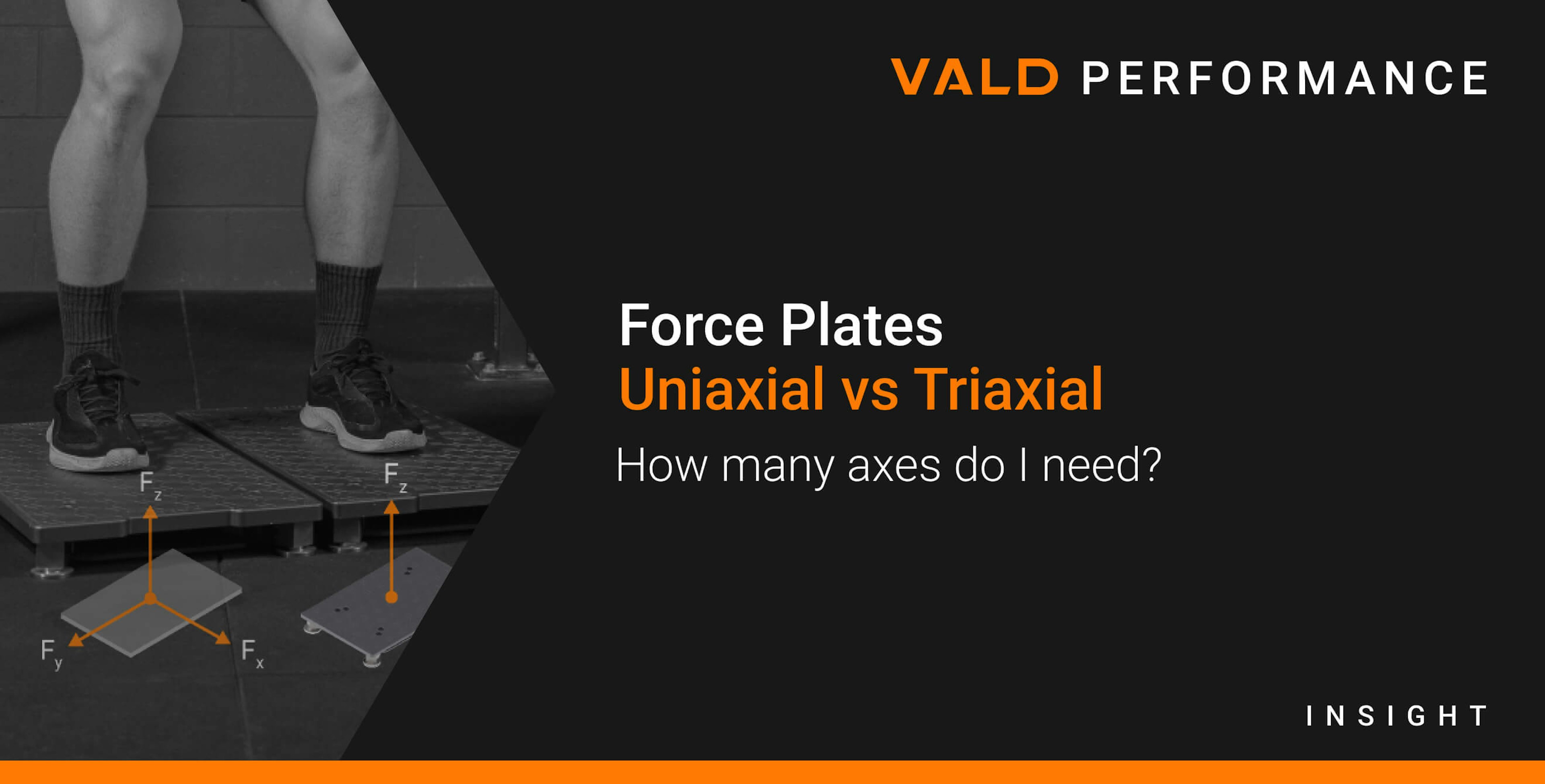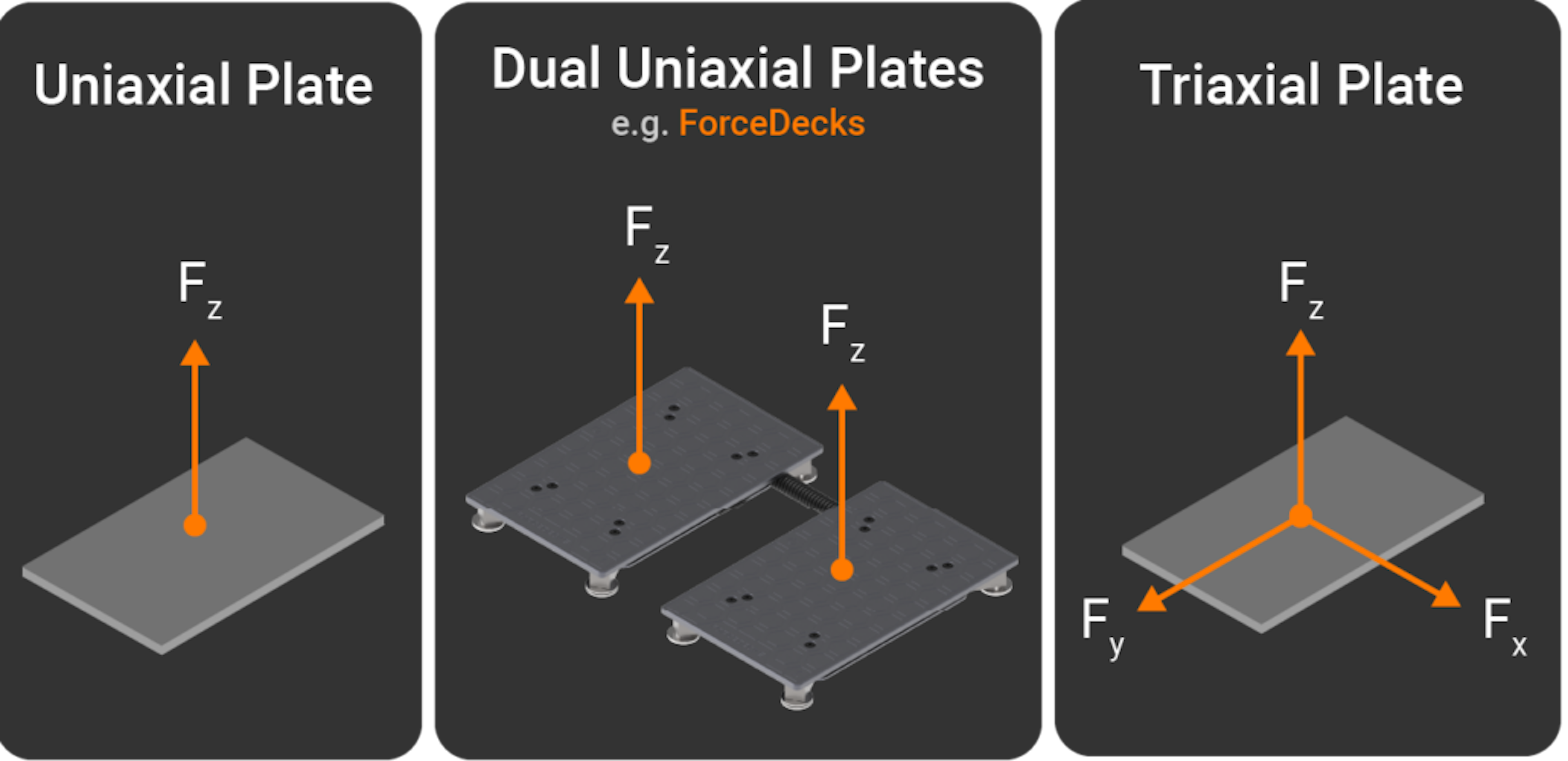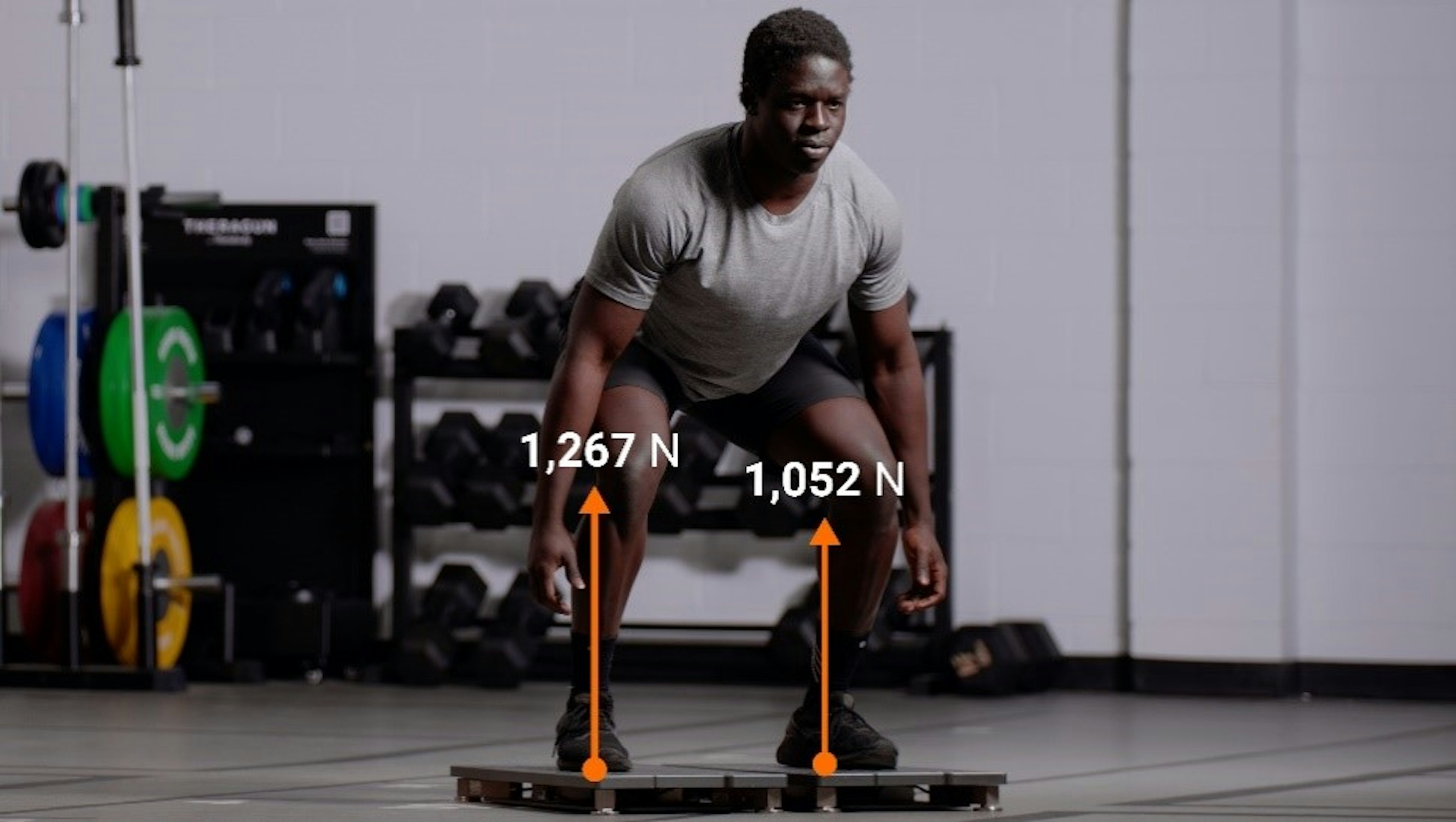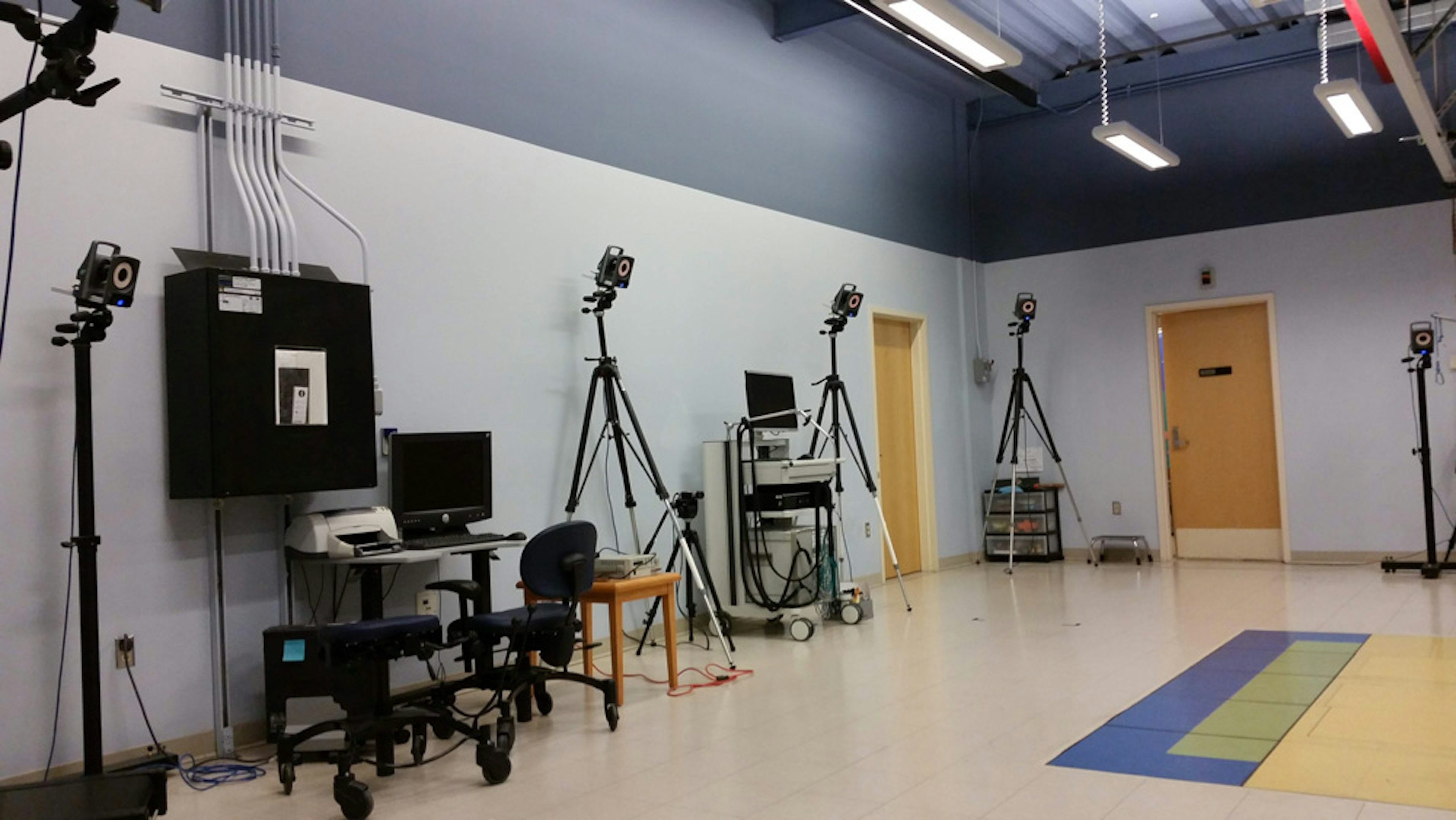Uniaxial vs. Triaxial Force Plates: How many axes do I need?

Force plates are now commonplace in strength and conditioning and high-performance environments, playing a key role in providing valuable insights into athlete performance. This is technology which, less than a decade ago, was limited to research facilities due to their cost and size.
The increasing accessibility of force plate technology is now extending beyond elite and professional sporting facilities, making its way into schools, private strength and conditioning centres and health facilities such as physiotherapy/physical therapy clinics.
… deciding on the right [force plates] to purchase to best suit your application and budget can be a confusing process …
While the adoption of force plate technology is on the rise, deciding on the right ones to purchase to best suit your application and budget can be a confusing process due to the sheer number of force plate variations, brands and models available today. These include options such as:
- Embedded vs. portable plates,
- Single plate vs. dual plates, and
- Uniaxial vs. triaxial plates
Each of these options, while sharing a common goal of capturing data that informs movement health and performance, have unique characteristics that make them suitable for specific applications. This article will focus on the distinctions between uniaxial and triaxial force plates, helping you make an informed purchase that aligns with your testing needs.

At the outset, it is important to note that ForceDecks software is compatible with both uniaxial plates (such as ForceDecks, Pasco and Fittech force plates) and triaxial force plates (including models from Kistler, AMTI and Bertec). No matter which you choose – or are contemplating choosing – we are happy to assist with your decision-making and implementation to ensure you get the most out of your force plate technology.
The Basics – what is the point of force plate testing?
Before diving into the world of uniaxial and triaxial force plates, it’s essential to understand the core purpose of these tools in performance assessments. Force plates are designed to measure the forces generated by athletes interacting with the ground during a wide range of movements and activities. This information is invaluable for assessing an athlete’s physical abilities, identifying strengths and weaknesses and minimizing injury risks. In essence, force plates are a tool for unlocking valuable insights into an athlete’s performance.
Force plates are designed to measure the forces generated by athletes interacting with the ground during a wide range of movements and activities. In essence, force plates are a tool for unlocking valuable insights into an athlete’s performance.

Uniaxial Force Plates
Vertical Measurement Axis
Uniaxial force plates measure forces in a single vertical axis. This axis captures forces acting down into the plate, such as those generated during jumping, landing, weightlifting and even standing still (for example during a balance test). The primary focus is on how athletes interact with the ground in a straight up-and-down manner.
Applications and Setup
Uniaxial force plates are perfect for applications where vertical force measurements take center stage. Key areas where they shine include jump testing, squat assessments, balance testing and any other activity where most of the force generated aligns with the vertical axis. Most users will find that all of the tests they wish to perform fit into this category, making uniaxial plates more than capable of satisfying their requirements.
Most users will find that all of the tests they wish to perform fit into this category, making uniaxial plates more than capable of satisfying their requirements.
These uniaxial tests are also typically faster to analyse, and for some force plate systems – such as ForceDecks – they can be automatically detected and analysed. It was this automatic analysis that allowed force plates to break free of university laboratories and become accessible to professionals working in the field, gym or clinic.
For these reasons, the broad suitability and fast analysis of uniaxial plates has made them the preferred choice for strength and conditioning coaches, physical therapists, physiotherapists, exercise physiologists, biokineticists and other movement health professionals who are regularly on the move or have limited time for complex setup procedures and manual data analysis.
The broad suitability and fast analysis of uniaxial plates has made them the preferred choice for those who are regularly on the move or have limited time for complex setup procedures and manual data analysis.
Uniaxial force plates are well-suited for both portable and embedded setups, due to typically being more lightweight and not needing to be permanently affixed to the floor. Whether you need a portable solution that can be set up and used in various locations or an embedded configuration for a dedicated testing environment, uniaxial plates deliver exceptional performance.
Cost and Value
Uniaxial force plates are also known for their cost-effectiveness. Since they measure forces in a single direction, they do not require complex multi-directional force sensors, which significantly increase the overall cost of a force plate. It is important to note, however, that this affordability does not necessarily imply any compromise in precision. For example, ForceDecks achieve vertical force accuracy equal to that of much more expensive triaxial force plates – they simply measure forces across less axes. This makes them a practical choice for those that require precise testing technology that won’t break the budget.
Uniaxial force plates are also known for their cost-effectiveness. Since they measure forces in a single direction, they do not require complex multi-directional force sensors
An athlete completing a CMJ on ForceDecks, with live data capture.
ForceDecks achieve vertical force accuracy equal to that of much more expensive triaxial force plates
Triaxial Force Plates
Measuring Along Three Axes
Triaxial force plates, as the name suggests, measure forces along three axes:
- Vertical (upward and downward forces),
- Anterior-posterior (forwards and backward forces), and
- Medio-lateral (side-to-side forces).
This data provides additional information on how forces act on an athlete during various movements.
Applications and Setup
Triaxial force plates are suitable for a wide range of testing scenarios, including most or all of the same as uniaxial plates, but also extending to those involving multidirectional movements such as agility tests, gait analysis and acceleration and deceleration assessments.
To maximize the accuracy and safety of triaxial force plate testing, it is usually necessary to embed them into the ground and often permanently affix them to the floor beneath using specialized adhesives.
To maximize the accuracy and safety of triaxial force plate testing, it is usually necessary to embed them into the ground and often permanently affix them to the floor beneath using specialized adhesives. This is primarily because anterior-posterior and medio-lateral forces can cause the plates to ‘slip’ horizontally, which can – at best – interfere with data collection and – at worst – create a safety hazard.
These requirements also mean triaxial plates must usually be selected, purchased and designed into the construction of the rooms in which they will be located, meaning a significant amount of forward planning can be required.
For tests like walking, sprinting and change-of-direction assessments, using embedded plates helps maintain a consistent floor level which allows natural movement and minimizes the risk of altering the athlete’s gait pattern or creating a tripping hazard.
For tests like walking, sprinting and change-of-direction assessments, using embedded plates helps maintain a consistent floor level which allows natural movement and minimizes the risk of altering the athlete’s gait pattern or creating a tripping hazard.
For detailed gait analysis, however, it is typically necessary to use at least two or ideally three triaxial plates to fully capture an entire stride cycle. This can in turn significantly increase the overall cost and complexity of the system.
Finally, triaxial plates typically offer limited or no auto-detection and auto-analysis functions like those of uniaxial solutions such as ForceDecks. Where ForceDecks can automatically detect exactly which of over 20 different movements an athlete is performing and automatically calculate up to 200 or more metrics from each movement, most triaxial systems are designed to simply output raw data. This means that any analysis you wish to perform with triaxial plates may require hours or days to complete, depending on the complexity. In research settings or biomechanics laboratories, this may be perfectly acceptable, however in performance or clinical settings this may prove impractical.
most triaxial systems are designed to simply output raw data. This means that any analysis you wish to perform with triaxial plates may require hours or days to complete, depending on the complexity.

Cost and Value
While triaxial force plates may technically offer three times as much data as uniaxial plates by measuring forces in three directions, they also come at a significantly higher cost, often three or more times that of uniaxial plates. This increased cost is primarily due to the construction and calibration of the sensors and associated electronics needed to measure, analyze and collect forces in three dimensions, which are significantly more complex than uniaxial sensors.
It’s important to note that while triaxial plates yield three times the data of uniaxial plates, this additional information doesn’t necessarily provide three times the value for most practitioners and scenarios
It’s important to note that while triaxial plates yield three times the data of uniaxial plates, this additional information doesn’t necessarily provide three times the value for most practitioners and scenarios. Whilst triaxial plates offer the capabilities to perform certain additional tests, if these tests aren’t regularly performed and the user doesn’t have the time or expertise to analyze the data, then it is difficult to realise the additional value.
When making the choice between force plates, consider both your budget and specific testing needs to determine if triaxial plates will provide enough additional value over and above that of uniaxial plates to justify their higher price tag.
Key Considerations for Your Testing
Define Your Testing Goals
The choice between uniaxial and triaxial force plates depends on your specific testing goals. If your primary focus revolves around vertical force data, for activities such as the countermovement jump, squat assessment, or balance assessment, uniaxial plates are a perfect fit. These plates excel at capturing the essential vertical component of force that underpins these movements, with triaxial plates offering negligible additional value to such tests. However, if your testing goals encompass gait analysis, sprint assessments or multidirectional movements, then you should consider embedded triaxial plates, as the lateral forces generated in those movements may be the key areas of interest.
Budget Matters
Uniaxial force plates are known for their cost-effectiveness. They provide precise force measurements in a single direction, eliminating the need for complex multi-directional force sensors that inflate the cost of a force plate. This cost-efficient solution is a practical choice for those seeking high-precision testing equipment that won’t strain their budget.
Uniaxial force plates are known for their cost-effectiveness. This cost-efficient solution is a practical choice for those seeking high-precision testing equipment that won’t strain their budget.
On the other hand, triaxial plates, while offering a broader scope of data with forces measured in three dimensions, typically come at a much higher price point due to the intricacies of constructing and calibrating the triaxial sensors. Weigh your budget constraints against the potential return on investment these force plates will provide for your specific testing goals.
Space and Portability
Uniaxial force plates are generally well-suited for environments with limited space, making them an excellent option for smaller facilities, as well as shared or multipurpose spaces. Many uniaxial plates such as ForceDecks are also portable, allowing them to be used in various locations such as gyms, clinics, at home, on the road or next to the field.
Uniaxial force plates are generally well-suited for environments with limited space… Their versatility extends to portability, allowing them to be used in various locations such as gyms, clinics, at home, on the road or next to the field.
Conversely, triaxial force plates typically require more space and a permanent or semi-permanent installation. These embedded plates are tailored to specific locations, ensuring stability during testing. To align your choice with your available space, consider the dimensions of your testing area and the level of mobility required for your assessments.
Testing Scope – Gait Assessments
If your work involves gait assessments or scenarios where you need to capture the entire stride cycle, a triaxial force plate system is usually the more suitable choice. Gait analysis typically requires two or more embedded triaxial plates as they provide a comprehensive understanding of ground reaction forces during the entire gait cycle. This advantage comes with the added complexity of using multiple plates and increased cost, but it’s a critical consideration for settings that require extensive gait assessments.
If your work involves gait assessments or scenarios where you need to capture the entire stride cycle, a triaxial force plate system is the usually the more suitable choice
| Uniaxial | Triaxial | ||||||
|---|---|---|---|---|---|---|---|
| Portable | Portable | Embedded | |||||
| Activity/Test | Single Plate | Dual Plate | Single Plate | Dual Plate | Single Plate | Dual Plate | 3+ Plates |
| Bodyweight | ✓ | ✓ | ✓ | ✓ | ✓ | ✓ | ✓ |
| Vertical Jumps | ✓ | ✓ | ✓ | ✓ | ✓ | ✓ | ✓ |
| Hop and Return | ✓ | ✓ | ✓ | ✓ | |||
| Isometric Strength | ✓ | ✓ | ✓ | ✓ | ✓ | ✓ | ✓ |
| Squat | ✓ | ✓ | ✓ | ✓ | ✓ | ✓ | ✓ |
| Horizontal Jump | ~ | ~ | ~ | ✓ | ✓ | ✓ | |
| Gait (Running/ Walking) | ~ | ✓ | ✓ | ✓ | |||
| Acceleration, Deceleration or Change of Direction | ~ | ✓ | ✓ | ||||
Uniaxial and triaxial force plates play essential roles in performance testing. Each has unique strengths and applications. By understanding the differences between these force plates and considering your testing goals, budget, space, and scope, you can make an informed choice that ensures you get a system that suits your needs and serves your athletes’ or clients’ goals. Whether you need precision along a single axis or comprehensive data along three axes, choosing the right force plate is important to ensuring you get the right bang for your buck.
If you are considering investing in force plate technology and would like some guidance, reach out and we’ll be more than happy to help.
